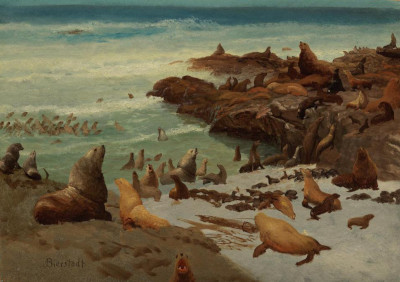Artist Albert Bierstadt is believed to have spent a period of time studying the environment of the Farallon Islands between the years of 1872-1873. This brought about a number of sketches that were then turned into paintings once he returned to his studio.
The artist captures a wealth of seals gathered together around this beach upon a popular set of islands which boasts an enviable selection of wildlife. Alongside the seals, one can also find whales and seabirds in great numbers and perhaps during the 19th century when this artist made his visit, there may well have been even more to see than there is today. The seals here are in a variety of positions, most likely these were created from the artist's mind directly onto canvas from his own studio. He would have sketches some of them individually at the time, and then laid out an approximate composition before then planning it in a more detailed fashion once he had returned home. It simply was not possible for him to effectively work outdoors in a windy, wild environment such as this, although the romance in us likes to imagine him sat patiently amidst this chaos, all those many years ago. He created a number of artworks whilst on the islands, including also Seal on the Rocks, Farallon Islands which itself features a much more dramatic scene.
The islands themselves are sometimes known as Devil's Teeth Islands due to the dangerous nature of this location, though this was what perhaps appealed to the artist in terms of creating drama which his paintings. He would have set off along the gulf of the Farallones in order to reach the islands, just off the coast of San Francisco, California. There is an abudance of wildlife but perhaps the stationery nature of seals made them the ideal choice for this artist, who was able to sit and sketch for hours on end without many of the creatures moving. He also would have to have considered his own safety during the 19th century, when trips into the wilderness were considerably more dangerous than they are today, with very little knowledge existing around some of the places that he journeyed to. Thankfully, he had the sense to travel amongst wider parties of people which also allowed him to share ideas with others as he went exploring these exciting locations.
This painting can be found in the Museum of Fine Arts in Boston, USA. They have given it a date of 1872 which feels entirely correct as we know that the artist visited these islands in that same year, and that other related paintings also carry a similar date too. This famous and respected institution hosts a good number of Bierstadt paintings, most of which are fairly small including a number of oil studies, which would bridge the gap between charcoal sketches and large scale oil paintings. The museum has also invested time in researching each item within their collection so that visitors can learn as much as possible about each one when visiting. They continue to serve American art particularly well, but also feature artworks from other regions, including famous artists such as John Singleton Copley, John Singer Sargent, Winslow Homer (including The Fog Warning), Childe Hassam and also Mary Cassatt.




